GENERAL AVIATION AERO22 show report
Friedrichshafen’s future flying machines
The annual Aero Friedrichshafen exhibition returned in April. CHRIS WRIGHT from the RAeS GA Group was in attendance to see the latest developments within the General Aviation world.
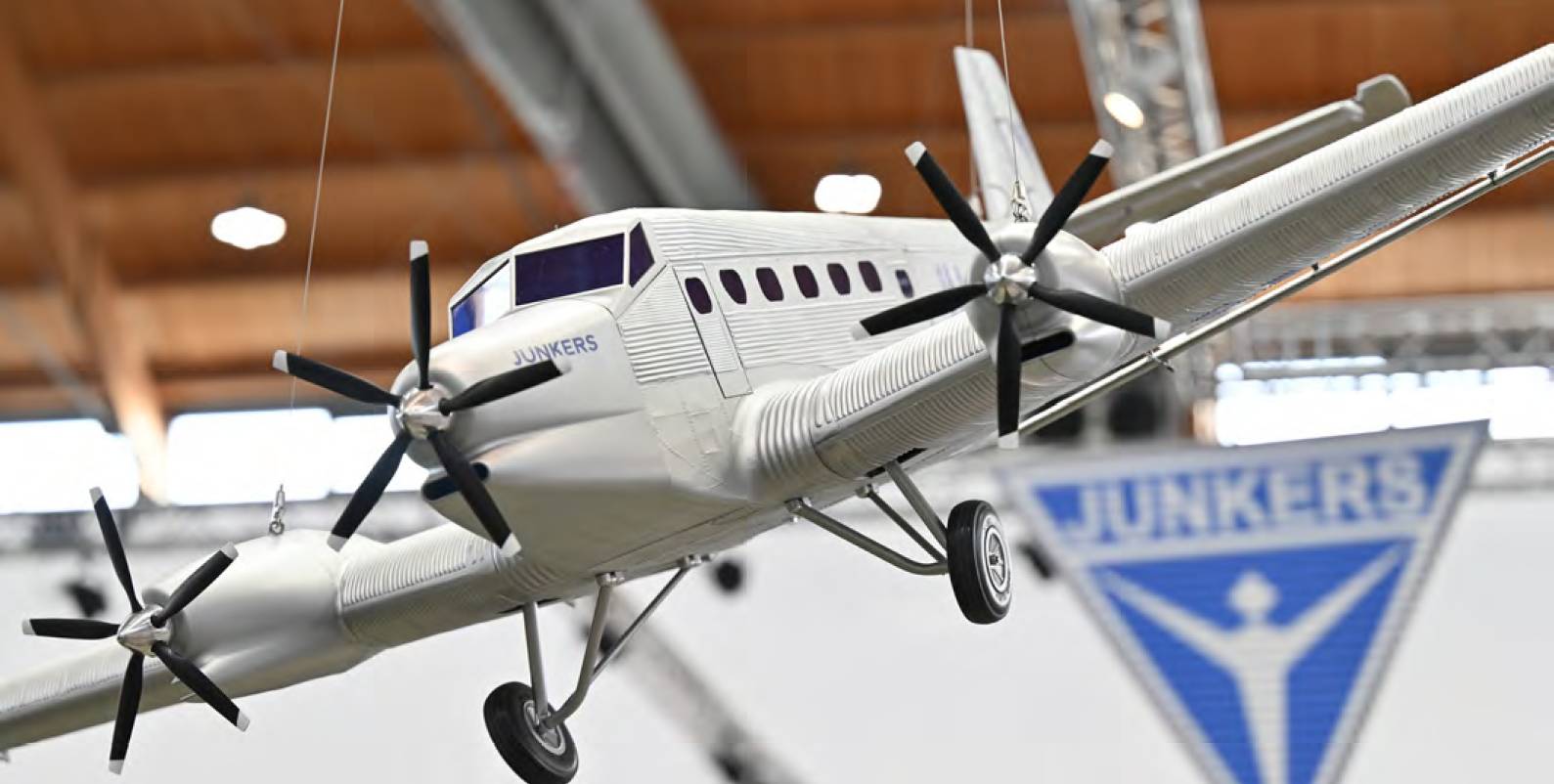 The ‘new’ Ju-52 is designed to use a trio of 500hp RED Aircraft diesel engines.
The ‘new’ Ju-52 is designed to use a trio of 500hp RED Aircraft diesel engines.
After a three-year hiatus due to the pandemic Aero, the justifiably self-titled ‘Global Show for General Aviation’ returned in April.
It was exciting to attend again with 633 exhibitors from 34 nations and aircraft present across the full range of GA, from hang-gliders through gliders, LSAs and larger light aircraft, gyrocopters, helicopters up to business jets. Drones were there in abundance too along with a great variety of avionics, simulators and components.
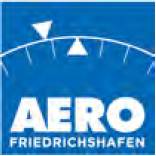 The crowds also turned out in their masses. Friedrichshafen has so much to offer – aeronautically, with this show and the Zeppelin and Dornier museums as well as, Lake Konstanz, the snow-capped mountains in the distance, lovely countryside and old towns.
The crowds also turned out in their masses. Friedrichshafen has so much to offer – aeronautically, with this show and the Zeppelin and Dornier museums as well as, Lake Konstanz, the snow-capped mountains in the distance, lovely countryside and old towns.
Aircraft and related technology can take years to develop so, the Covid break has led to more new products and a greater refreshment of existing products than usual. Once again, I was able to spend two days at the show, in my first circuit absorbing as much as I could and then directing my focus on what sparked my interest. It would take several articles to do justice to the wider range of aircraft, rotorcraft and avionics; so some will get a brief mention.
My immediate impressions were of some interesting powerplant developments, an increasing number of two-seat LSA (under 600kg) aircraft and an interesting variety of Akaflieg and university projects – I’ll start with these.
The German Idaflieg – which is short for Interest Group of Academic Aviation Groups – is the umbrella organisation of the researching Akafliegs in Germany. Akaflieg is short for Academic Aviation Group. Akafliegs are generally glider clubs that are university-based and are primarily made up of volunteer university members. The Idaflieg represents the Akafliegs externally and organises the co-operation between them as well as with external research institutions, such as the German Aerospace Centre (DLR).
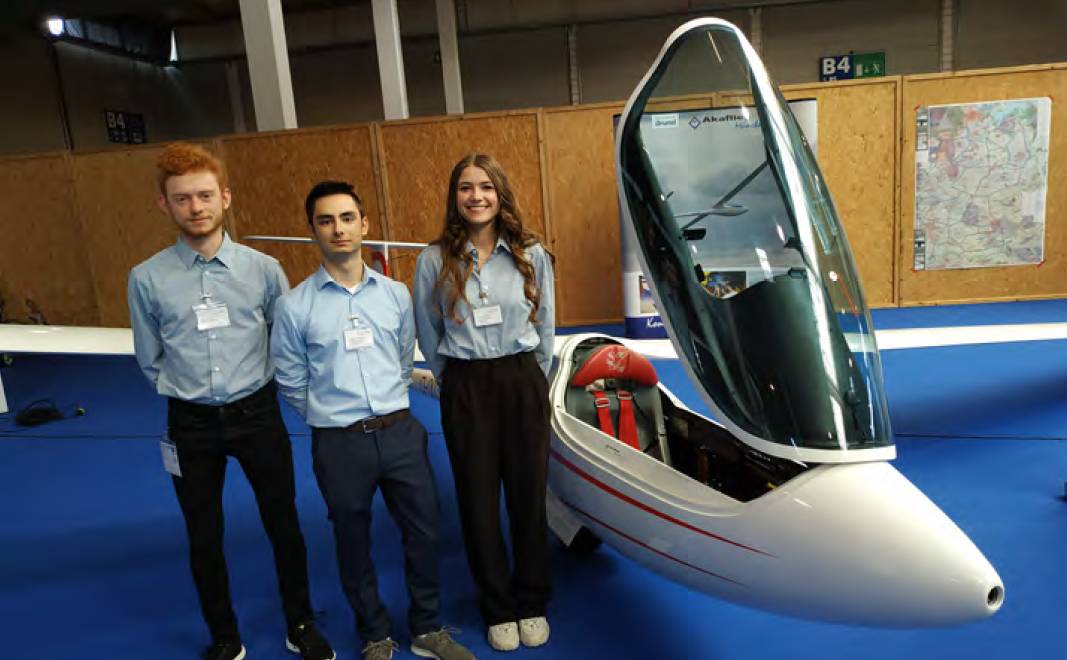 Members from 7 Akafliegs
Members from 7 Akafliegs
Founding members from the 1920s including academic flying groups from Aachen, Braunschweig, Darmstadt, Dresden, Munich and Stuttgart were represented at Aero 2022, as well as Karlsruhe and a more recent start-up, Hochschule Esslingen.
Every year the Idaflieg organises a three-week summer meeting at the Aalen-Elchingen airfield, where the flight characteristics and performance of gliders and prototypes of the Akafliegs are flight tested. Over the years, full-scale glider and powered aircraft have been designed, built and flown and other projects include component improvement and avionics and other technical research.
Testing the projects centrally enables lower-cost subsidised operation, help from the DLR and great benefit with the Akafliegs meeting together and sharing technical experience and know-how.
The members commit to working a significant number of hours on projects annually and gain tremendous experience, including flying and maintenance – and where students display sufficient experience and capability they also take part in the flight testing. The onward benefit to the German aviation industry is clear and has laid the foundations for the successful sailplane manufacturing industry.
The students of Aachen demonstrated three projects: a lightweight retractable towrope system which is incorporated in a glider towing aircraft and is being readied for sale (FVA 24); a touring motor glider with twin electric motors on a V tail; and a self-sustaining e-glider, the FVA 29 which is based on the ASW 28 sailplane. The main display item was the ‘iron-bird’ simulation of the engine and batteries for the twin-engined touring glider. It has been created to simulate a variety of range extenders such as fuel cells or hydrocarbon systems.
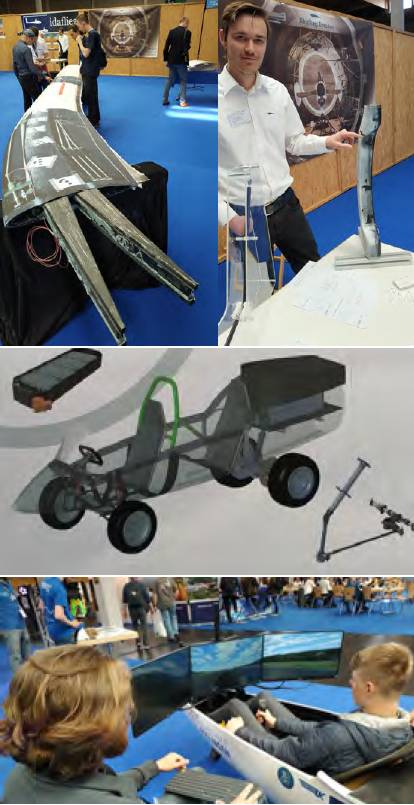 From bottom: Glider simulator, Esslingen Akaflieg’s Project E16 is an electric glider and winch cable recovery cart, AK-X wing with control rods, and Dresden’s composite strut designed to protect the rear seat occupant’s head in the event of a sudden full stop. (all images via author unless otherwise stated.)
From bottom: Glider simulator, Esslingen Akaflieg’s Project E16 is an electric glider and winch cable recovery cart, AK-X wing with control rods, and Dresden’s composite strut designed to protect the rear seat occupant’s head in the event of a sudden full stop. (all images via author unless otherwise stated.)
Akaflieg Braunschweig’s prototype gliders, including SB 7, SB10, SB11 and SB14, are still flying and explored novel materials and wing planforms.
The SB11 was notably successful in competition. The group’s latest project is the SB15 and the crashproof test fuselage was on display at Aero 2022.
The two-seat SB 15 will use the elegant high aspect ratio wings of the SB14 single-seater, extended at the roots and tips.
The member I spoke to described how some flight testing is done by students with some being comparative testing of commercial gliders flown together with a glider of known performance. All members have an opportunity to fly.
Darmstadt has the D43 two-seat side-by-side trainer which first flew in 2014 and is still in flight testing and certification.
The students benefit from learning the certification process with the LBA – equivalent to the CAA. Follow-on projects are the D44, a ballistic recovery system for the D43 and the D45 lightweight single-seat glider.
Dresden projects include the manufacture of spiral wound carbon fibre control rods and also the composite strut to protect the rear seat occupant’s head in the event of a sudden full stop where the leading edges of the wings would otherwise pinch closed as the wings swing forward.
Esslingen Akaflieg describe themselves as relative newcomers with stepping stone projects but their website gives a history of significant projects.
Project E16 is an electric glider and winch cable recovery cart and E17 is the ‘ApisJet’ where the two-stroke self-sustaining engine on a standard 15m glider is being replaced by a microturbine within the fuselage.
Containment and fire suppression need to be addressed and the glider will give experience in flight testing and in research into biofuels. Esslingen also had a glider flight simulator at the show.
Karlsruhe displayed their latest project as a strength test version at Aero 2019. The AK-X flying wing was based on the experience gained with the Braunschweig SB13 and the Horten flying wings.
The wing shown at this year’s event had been taken out of its mould earlier in the week and the control rods to the triple flap/elevon system were depicted on the wing, as were the control runs ahead of the spar to the airbrake and rudder.
These latter controls run through the water ballast tank in tubes. The curved wing and wing tip structure are geometrically challenging with a tip mould, including the control run to the rudder was exhibited at the event.
The Stuttgart Akaflieg was displaying their fs 35 Harpyie and fs 36 projects at the show. The Harpyie, named after a South American eagle, is a motor glider based on the very successful Diamond Dimona but with significant changes including extended wings and fin, winglets and a Continental CD 155 diesel engine. It first flew in 2019 and is capable of towing the heaviest of gliders, including the 850kg NimETA.
The fs 36 is a competition glider and features fly-by-wire control and a retracting flap system that increases the chord length by approximately 20%. FBW has only recently been flown on a US glider and carries certification issues.
The Akaflieg is working with the Institut of Avionics on the FBW system and is sponsored by the Federal government as a Lufo (Luftfahrtforschungsprojekt- Aeronautical Research) project.
Akafliegs also exist in Austria, Denmark, Finland, Netherlands (Delft), Poland and Spain with links to the Idaflieg.
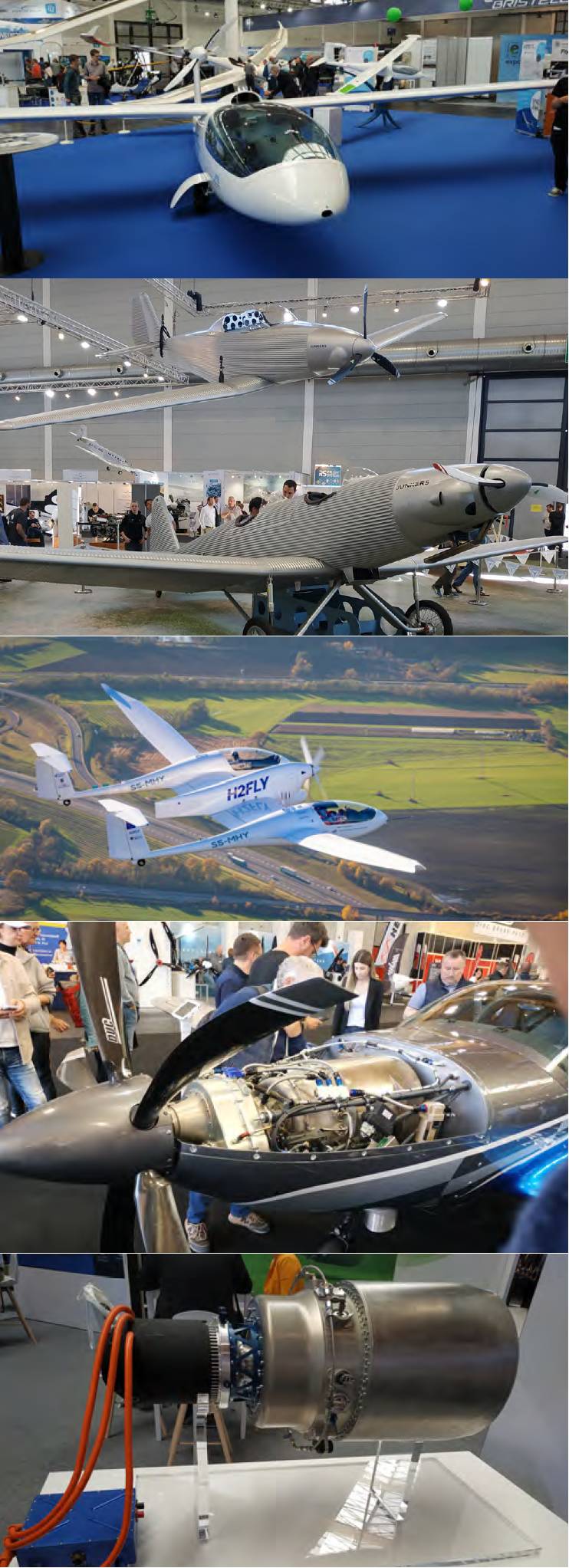 Left, top to bottom: The e-Genius hybrid designed by Stuttgart University has a 1,000km range, replica Junkers A50 and A60 trainer, the hydrogen powered H2FLY HY4 flew into the show from Stuttgart, TP-90 in a JMB VL3 aircraft, TG-R90 generator.
Left, top to bottom: The e-Genius hybrid designed by Stuttgart University has a 1,000km range, replica Junkers A50 and A60 trainer, the hydrogen powered H2FLY HY4 flew into the show from Stuttgart, TP-90 in a JMB VL3 aircraft, TG-R90 generator.
Other university exhibits in electric aircraft and flight simulation were evident in Aero 2022 and notable in this context is the work done by Stuttgart University Institute of Aircraft Design with the two-seater electrically-driven e-Genius.
The hybrid version powered by a Wankel engine has demonstrated a 1,000km range and a compact 80hp FLYECO three-cylinder fuel-injected, turbocharged diesel is being fitted to give yet more economy.
The engine is derived from a Mercedes car engine and has been tested on a Funk FK9 were it demonstrated remarkably low-fuel consumption in the order of 7l/h.
The RAeS GA group is working on a Design/Make/Fly initiative, inspired by the achievements across Europe, to tap into the potential of UK universities and manufacturing capability: the Idaflieg and Akaflieg examples show what can be done both to generate leading-edge projects and, more importantly, a pool of highly experienced and enthusiastic aeronautical engineers.
The e-Genius project leads naturally on to consider some of the other power-system projects on display.
Other diesel engine developments seen were the Continental CD 300, which is the latest and largest of a series of JetA/diesel GA powerplants, and the 500hp Raikhlin Aircraft Engine Developments (RED Aircraft) A03 – the latter displaying a 2022 first-class award.
RED Aircraft certified its 500hp diesel in 2014 and that unit has been chosen to re-engine a ‘reborn’ Junkers Ju 52.
No doubt it will be much quieter than the original Ju 52, which was nicknamed Tante Ju (‘Auntie Ju’) and advertised its presence some way off.
The Junkers project and the DIMOR AERO group is owned by Dieter Morszeck who has a passion for vintage aircraft and also owns WACO.
The Morszeck’s Junkers F13 replica appeared at Aero 2019 while two further Junkers replicas appeared at this year’s event – the A50 tandem two-seater and the newer A60 side-by-side trainers.
Both are Rotax powered and fall within the 600kg microlight limit. They boast the characteristic Junkers corrugated surfaces and the A60 has a retracting undercarriage.
Another exciting new propulsion venture on display at the show was the XAEROS Hybrid 200.
This is a compound engine combining three independent motors clutched into one integrated drive unit.
Two motors are turbocharged fuel-injected petrol V twins of about 700cc capacity and the front motor is an electric motor.
The system creates a maximum of 270hp/200kW with max continuous of 160hp/118kW. Each motor can also be run independently, giving safety should one fail.
The Hybrid 200 is a remarkably compact engine measuring just 500mm (W) x 510mm (D) x 790mm (L) – about half the width of an equivalent four-cylinder horizontally opposed engine and less depth, meaning retrofit could give a much cleaner cowling.
Using electric power for taxi and descent as well as its adaptability to synthetic fuel and ability to fit existing aircraft make this an excellent environmental solution. It awaits a backer.
A somewhat similar approach using an electric motor with a Rotax was shown on several examples, such as the CFM Air DARDO. Again, this aircraft was one of the many Light-Sport Aircraft on display that fell within a 600kg MTO weight.
Striking in its proven capability are the Turbotech achievements. Turbotech displayed its 100kW TP-90 turboprop. It has an installed weight of 80kg and a corresponding turbine-driven generator.
The TP-90 has been extensively tested and was displayed at Aero 2022 fitted to the JMB VL3 Evolution (LSA) and a Bristell B23. The VL3 first flew earlier in April and was understood to have flown in to Friedrichshafen from the Czech Republic.
The Turbotech turboprop has an impressive 3,000 hour TBO and is remarkably economical due to its regenerating heat exchanger – it claiming about 17l/hr at cruise speeds. It also has multi-fuel capabililties and is able to run on Jet-A1/Diesel/UL91/AVGAS/ Bio Fuel/H2. Turbotech makes a corresponding generator set in two sizes (55kW and 90kW), suitable for electric aircraft range extenders.
Other turbogenerators and electric/petrol hybrids were on display but mention must be made of the hydrogen and fuel cell-driven electric-powered aircraft at the show.
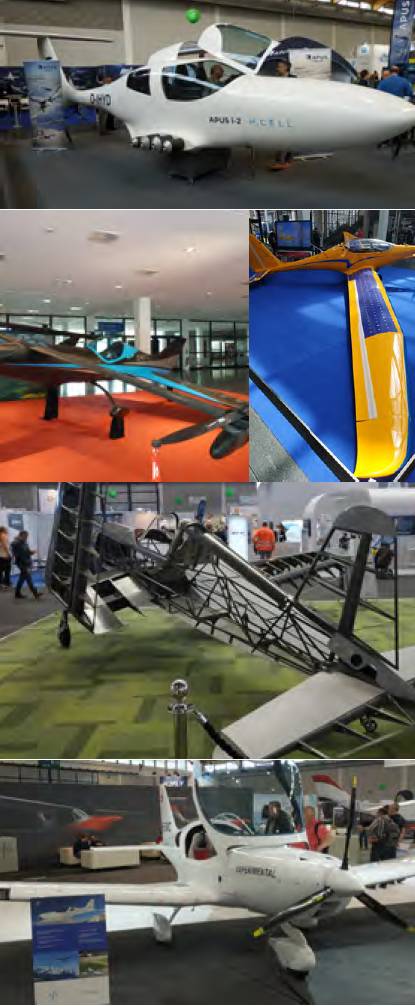 Above top to bottom: APUS i-2 4 seat twin, eMagic One (l), Elektra Solar Trainer, (r), JH ultralight Corsair CF structure, Bristell B23 Energic.
Above top to bottom: APUS i-2 4 seat twin, eMagic One (l), Elektra Solar Trainer, (r), JH ultralight Corsair CF structure, Bristell B23 Energic.
The H2FLY HY4 aircraft uses hydrogen from compressed storage and ambient oxygen to generate electricity for thrust and flew a 77-mile journey from Stuttgart to Friedrichshafen early in April. H2FLY is funded by the German government to develop the first one-megawatt fuel cell system for aviation use.
The APUS i-2 four-seat twin is one of a series of projects that use compressed hydrogen-feeding fuel cells. The hydrogen is carried in four tubes in both wings which form part of the load-carrying structure. Performance better than that of the Cirrus SR22 is claimed but emission-free.
A limited number of pure electric (plus battery) powered aircraft were on display at Friedrichshafen. The eMagic One is a proven, very lightweight eVTOL single-seat aircraft with a single 40kW electric motor for drive and eight 15kW motors for vertical flight.
Meanwhile, the Elektra Solar Trainer two-seater had a 50kW motor and solar cells to increase range. The cruise power is 12kW giving a maximum flight time of 2.5hr on a sunny day. The aircraft also falls within the 600kg LSA limit.
Czech-based BRM demonstrated the Bristell B23 LSA that it had adapted with an H55 Swiss electric propulsion system. This is the first trainer to be certificated to EASA CS-23 and it is fitted with sufficient batteries to give an hour's flight plus 30 minutes cruise power. The addition of these extra batteries has resulted in a weight of 850kg.
The beauty of the annual Aero event is the pure breadth of GA types that are demonstrated.
The 2022 event saw everything from gyrocopters to the Cirrus Vision private jet, not to mention avionics, autopilots, headsets, navigation aids and components.
Then there were kit-planes such as the ultralight JH Corsair (which falls into the sub-120kg class and demonstrated a remarkable carbon-fibre tubular structure) and inspirational characters such as 19-year-old Zara Rutherford, who recently flew around the world in a Shark.
Aero Shark UL ultralight. We congratulate her and the Shark team on their magnificent achievement and follow her younger brother’s quest to follow in her wake with interest.
Next year’s Aero event is scheduled to take place at Messe Friedrichshafen on 19-22 April, 2023.